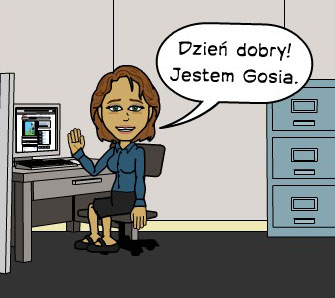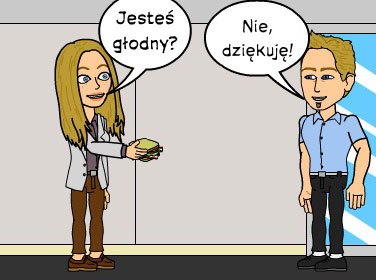Lesson 1
In this lesson, you’ll learn:
VOCABULARY AND PHRASES
- greetings
- introductions
- nationalities
- professions
GRAMMAR:
- Personal pronouns
- The verb ‘be’
- Instrumental case after ‘be’
- Y/N questions
Meet the characters from the course. They start working together in Wrocław.




|
Cześć |
Hi (used also as bye) |
|
|
Jestem Ania. |
I’m Ania. |
|
|
Dzień dobry. |
Good morning / Good afternoon. |
|
|
Dobry wieczór. |
Good evening. |
Saying Jestem + your name is the simplest way of introducing ourselves, though it is a bit informal.



|
Jak masz na imię? |
What’s your name? (literally: What do you have as a name?) |
|
|
Jak macie na imię? |
What are your names? |
|
|
Ja jestem Ania, a to jest Tomek. |
I’m Ania and this is Tomek. |
|
|
Kto to jest? |
Who's that? / Who is it? |
|
|
To jest Gosia. |
That / this is Gosia. |
Personal pronouns
Personal pronouns in Polish are used less frequently than in English, German or French. The verb form unambiguously implies the person so the verb does not have to be preceded by a personal pronoun, unless the speaker wants to put emphasis on it.
However personal pronouns are still a vital element of language and it’s absolutely necessary to know them.
|
ja |
I |
|
|
ty |
you |
|
|
on |
he (inanimate objects also have gender) |
|
|
ona |
she (inanimate objects also have gender) |
|
|
ono |
it |
|
|
Pan |
you (formal when addressing a man) |
|
|
Pani |
you (formal when addressing a woman) |
|
|
my |
we |
|
|
wy |
you (two or more) |
|
|
oni |
they (men or a mixed group) |
|
|
one |
they (group consisting only of objects of feminine or neuter gender) |
|
|
Państwo |
You (formal when addressing two or more people) |
OK. It’s time to learn your first verb inflections. As mentioned earlier – verb forms are different for each person. So far you have come across two verbs: być (to be) and mieć (to have)
|
być |
|
|
ja jestem |
|
|
ty jesteś |
|
|
on / ona / ono jest |
|
|
my jesteśmy |
|
|
wy jesteście |
|
|
oni / one są |
After Pan and Pani the third person singular is used
After Państwo the third person plural is used
Related interactive test: The verb "be".» take the interactive test
YES/NO Questions
In Polish, it’s easy to ask questions. The word order of a sentence stays the same – you only indicate that you’re asking a question by intonation. Additionally, the interrogative pronoun CZY can be added at the beginning of a sentence, but it’s usually unnecessary.


|
Cześć! Jesteś w domu? |
Hi! Are you at home? |
|
|
Jesteś głodny? |
Are you hungry? |
|
|
Nie, dziękuję! |
No, thank you! |
In the examples below, the characters use the verb ‘to be’ to tell us about their professions:




|
architekt |
an architect |
|
|
tłumacz |
a translator/an interpreter |
|
|
tłumaczka |
a (female) translator/an interpreter |
|
|
sekretarka |
a secretary |
|
|
informatyk |
a computer scientist |
|
|
Jestem architektem. |
I’m an architect. |
|
|
Jestem tłumaczką. |
I’m a translator. |
|
|
Jestem sekretarką. |
I’m a secretary. |
|
|
Jestem informatykiem. |
I’m a computer technician. |
Take the test below and learn more professions:
Related interactive test: Professions - picture test.» take the interactive test
You may have noticed that the nouns indicating professions change after the verb ‘jestem’. Even for those who speak a language that has cases (as in German), it might be hard to grasp that we inflect nouns even after the verb BE. Well, you just have to put up with it. German has only 4 cases, Polish has 7. Yes. It might be challenging, but we are sure you like challenges and you’ll cope with it successfully. Furthermore, remember that perfect grammatical accuracy is not your aim at the beginning.
Ladies and gentlemen, let me introduce the instrumental case. We use it after the verb be (when mentioning profession or nationality)
Jestem lekarzem. (I’m a doctor).
On jest Francuzem. (He’s French.)
! Note that in Polish nous are used to talk about nationality, not adjectives as in English (literally: He’s a Frenchman).
Read more in the separate article about the instrumental case.
Female forms
No natural language is logical or consistent. Polish is no exception and can bevery inconsistent about creating feminine forms for professions. In most cases, the feminine form may be created by adding -KA to the masculine form
nauczyciel - nauczycielka
policjant - policjantka
but generally it is acceptable to use masculine forms when talking about a woman’s profession.
Sometimes, the feminine forms sound awkward and are not widely used; sometimes, they are impossible to create. If you are beginner, it is quite safe to always use masculine forms. But remember – this applies to professions, not to nationalities, when feminine forms must always be used for women.
Francuz – Francuzka
Related interactive test: Instrumental case.» take the interactive test
Related interactive test: Nationalities (masculine).» take the interactive test
Related interactive test: Nationalities (female).» take the interactive test
Related interactive test: Revision - lesson 1.» take the interactive test
 LearnPolish
LearnPolish